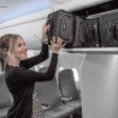Bags of problems
February 1, 2016

The fierce ongoing debate about carry-on baggage allowances has pitted the airline industry’s global policy-setting group against individual airlines amid predictions it could lead to the return of a standardized system that was abandoned years ago. It has also raised more questions than it answers.
The International Air Travel Association’s “Cabin OK” recommendations, introduced in June, were quickly put on hold in the face of stiff opposition, particularly in the US.
Industry figures pointed out that the proposals flew in the face of trends among aircraft manufacturers for bigger overhead bins, and among travelers who are putting greater reliance on carry-on baggage.
Generally accepted guidelines were introduced decades ago, but their legality was challenged by some governments, and airlines ultimately set their own allowances.
IATA’s latest suggestions for carry-on baggage dimensions of 55 x 35 x 20cm (21 x 14 x 8 inches), were developed in partnership with several member airlines and aircraft manufacturers.
“We worked with the aircraft manufacturers to define a cabin-sized carry-on bag that can fit in either the overhead compartment space or under the seat in front of the passenger,” says Albert Tjoeng, IATA’s assistant director for corporate communications, Asia-Pacific.
“This size was calculated to make the best use of storage space in the cabin. If fully embraced by passengers, everyone would have a chance to travel with their carry-on bags on board aircraft of 120 seats or larger, even when the flight is full.”
Compared to the existing guidelines set out by several Asian carriers, IATA’s “Cabin OK” recommendation was noticeably limited. Cathay Pacific, for instance, has a size allowance of 56 x 36 x 23cm (22 x 14 x 9 inches), while Singapore Airlines requires that the sum of the length, width and height of each carry-on bag should not exceed 115cm (45 inches). IATA’s recommendation adds up to only 110cm (43 inches).
Airlines for America, the trade organization representing principal US airlines, including the big three (American, Delta and United) was particularly vocal in its rejection of the guidelines.
“A4A and its members reject the recent carry-on size initiative put forth by IATA because it is unnecessary and flies in the face of the actions the US carriers are taking to invest in the customer experience – roughly $1.2 billion a month – including larger overhead bins,” says A4A president and chief executive Nicholas Calio.
Calio’s comments about the sizeable investment being pumped into developing larger overhead bins are reflected in the latest generation of cabin interiors. Airbus and Boeing have launched innovations in the past two years that guarantee extra stowage space on next-generation aircraft. Aimed at the single-aisle segment, where space is usually an issue, Airbus’ pivoting stowage options and Boeing’s new space bins deliver more baggage space onboard.
Airbus’ pivoting bins were developed for the manufacturer’s narrow-body aircraft family, the A320. Taking advantage of the airplane’s wide fuselage cross-section, the new bins offer 10 percent increased volume over the existing designs, but are still capable of accommodating up to 60 percent more luggage by allowing bags to be stowed on their sides rather than flat.
Boeing’s Space Bins for the 737 have been designed to hold six standard-sized bags – two more than the existing pivot bins. This has been achieved by lowering the height of the bin lip, which, like the A320, allows for vertical rather than flat stowage.
Cheap Comes at a Cost
The challenge here, however, is whether such innovations can actually keep up with the popularity of carry-on luggage, as a growing number of cost-conscious travelers favor hand carrying their bags instead of paying for checked baggage – a common tactic for low-cost carriers that generally offer lower fares but fewer comforts, too.
Andrew Herdman, director general of the Association of Asia-Pacific Airlines believes this development poses a number of complications that carriers will have to deal with accordingly.
“This shift towards greater reliance on hand-carried luggage has led to problems, including increasingly common situations where the storage space in the aircraft cabin is insufficient to satisfy the requirements of all the passengers on board,” says Herdman.
“Consequently, airlines have to spend time and effort to rearrange passengers’ luggage, in some cases having to load hand-carried items in the lower cargo hold of the aircraft. The fact that average industry load factors have risen steadily over recent decades, and are now approaching 80 percent, only adds to such pressures.”
Airlines, particularly those that impose charges on checked baggage, are also inclined to restrict the amount of carry-on luggage accordingly, Herdman says.
A look at three Asian low-cost carriers – Air Asia, Scoot and Jetstar Asia – reveals that the carry-on allowances, based on individual baggage dimensions (maximum 115cm, or 45 inches) and weight (7kg, 15 lbs.), remain consistent with full-service airlines. Air Asia’s and Jetstar’s allowances, for instance, are exactly the same as Cathay Pacific, while Scoot’s is identical to its parent company, Singapore Airlines.
The differentiator is that low-cost carriers typically offer checked baggage for a fee unless the passenger is in a premium cabin. The idea of forking out an additional $40 to check in up to 33 lbs. of luggage on Jetstar can be a turn-off for passengers that choose to fly with the carrier for its low fares.
“A significant development in the past decade is the decision by some airlines to unbundle their services and impose specified baggage charges for some or even all items of checked baggage,” says Herdman.
“While such policies aim to more closely match the overall fares with the actual services provided to individual passengers, it also leads to other changes in consumer behavior.”
Interline Issues
Another point that Herdman notes is potential complications that travelers might face when connecting between flights. While connecting travel has matured to the point where the majority of connections are usually seamless, problems can arise when passengers are connecting between two carriers that do not have codeshare or interline partnerships.
“The proliferation of different schemes and charges, each governed by detailed rules and variations for different customer groups, has led to increasing complexity of consumer choice, and particular complications for codeshares and interlining connections,” he says.
These sentiments are echoed by Nicholas Ionides, SIA’s vice president of public affairs, who comments on the company’s standard policy when a customer travels first on an airline that does not have codeshare/interline with SIA, and subsequently with the Singapore flag carrier.
In this scenario, “it is very likely that the customer would be holding two different air tickets,” Ionides says. “The customer would have to abide by the baggage allowance stated for each ticket. This means that he/she would have to collect his/her checked baggage (from the first carrier) and re-check in his/her baggage for the subsequent flight with SIA.”
A Complex Business
Further complicating matters is the implementation of “piece” and “weight” concepts for checked baggage, depending on routes. The former applies for flights over the Atlantic Ocean, whereby the acceptable amount of checked baggage is determined by the number of individual bags that are being checked in.
In this case, the standard acceptable baggage allowance on economy class is typically set at no more than two pieces of checked luggage, with each piece weighing in at about 50 lbs.
On the flip side, flights that do not serve the US or Canada (this may, however, vary) usually institute the “weight” concept. In this situation, each passenger is allowed to check an undefined number of bags into the aircraft, as long as it is within the combined weight limits. This typically varies from about 44 lbs. in economy class to 110 lbs. for first class passengers.
Herdman believes IATA’s attempt to introduce voluntary guidelines for carry-on baggage limitations, if widely adopted, will increase the likelihood of airlines accommodating all passengers’ hand-carried items in the cabin. But he cautions that the initiative requires further review before it can be implemented successfully.
“Some governments and regulators have expressed concern about the increasing complexity of different baggage-charging schemes, and have raised the possibility of regulating the provision of such services, perhaps even including specifying a standardized minimum free baggage allowance,” he says.
“It would be deeply ironic, if in the final analysis, we were to adopt a government-imposed regulatory solution that in effect would replicate the original market-driven framework of standardized baggage allowances that served both industry and consumer needs reasonably well for many years,” Herdman concludes.




